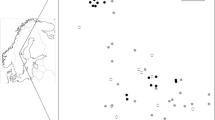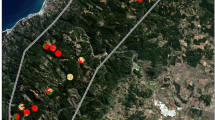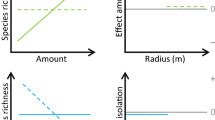Abstract
We investigate relevant scales and cost-efficient methods for measurements of habitat for saproxylic, aspen-associated beetles, in two boreal forest landscapes in south-eastern Norway. We sampled saproxylic beetles with window traps on fresh aspen dead wood and conducted field surveys of dead wood in the surroundings (1, 2 and 3 km radius). In addition, we used maps derived from satellite imagery to extract data on forest age and volume for the same surroundings. We found that species richness of saproxylic beetles was related to dead wood volume estimated by field survey within 1 or 2 km radius from the trapping points. However, the map-derived variable describing area of forest with high levels of deciduous wood volume was the overall best predictor of species richness. The scale of response to this variable differed; species richness of all saproxylic beetles was best predicted by estimates for the 2 km radius whereas richness of species more strongly associated with aspen was best predicted by estimates for the 3 km radius. This might indicate that aspen-associated beetles disperse over larger distances than many other beetles; possibly an adaptation to the scattered distribution and ephemeral nature of aspen dead wood in boreal forests. Our results show that substrate variables must be measured at the scale that is ecologically relevant for the study organism to elicit a response. We also show that remote sensing data -often easy to obtain for large scales—can be used to complement studies of scale-specific responses and thus improve conservation measures for saproxylic beetle species.




Similar content being viewed by others
References
Akaike H (1974) A new look at the statistical model identification. IEEE Trans Autom Control 19:716–723
Andersson J, Hjältén J, Dynesius M (2012) Long-term effects of stump harvesting and landscape composition on beetle assemblages in the hemiboreal forest of Sweden. For Ecol Manag 271:75–80. doi:10.1016/j.foreco.2012.01.030
Anon (2006) Living forests. Standard for sustainable forest management in Norway. http://www.levendeskog.no/levendeskog/vedlegg/51Levende_Skog_standard_Engelsk.pdf
Bater CW, Coops NC, Gergel SE, LeMay V, Collins D (2009) Estimation of standing dead tree class distributions in northwest coastal forests using lidar remote sensing. Can J Forest Res 39:1080–1091
Bergman KO, Jansson N, Claesson K, Palmer MW, Milberg P (2012) How much and at what scale? Multiscale analyses as decision support for conservation of saproxylic oak beetles. For Ecol Manag 265:133–141. doi:10.1016/j.foreco.2011.10.030
Birkemoe T, Sverdrup-Thygeson A (2015) Trophic levels and habitat specialization of beetles caught on experimentally added aspen wood: does trap type really matter? J Insect Conserv 19:163–173. doi:10.1007/s10841-015-9757-6
Blanchard SD, Jakubowski MK, Kelly M (2011) Object-based image analysis of downed logs in disturbed forested landscapes using lidar. Remote Sens 3:2420–2439
Dahlberg A, Stokland JN (2004) Vedlevande arters krav på substrat Skogsstyrelsen. Rapport 7:1–74
Dalgaard P (2008) Introductory statistics with R. Statistics and computing, Second edn. Springer, New York
Dennis RL, Shreeve TG, Van Dyck H (2006) Habitats and resources: the need for a resource-based definition to conserve butterflies. Biodivers Conserv 15:1943–1966
Dover JW (1996) Factors affecting the distribution of satyrid butterflies on arable farmland. J Appl Ecol 33:723–734
Fahrig L (2013) Rethinking patch size and isolation effects: the habitat amount hypothesis. J Biogeogr 40:1649–1663
Fridman J, Walheim M (2000) Amount, structure, and dynamics of dead wood on managed forestland in Sweden. For Ecol Manag 131:23–36
Gärdenfors U (2010) The 2010 red list of Swedish species. ArtDatabanken, Sweden
Gibb H, Ball JP, Johansson T, Atlegrim O, Hjältén J, Danell K (2005) Effects of management on coarse woody debris volume and composition in boreal forests in northern Sweden. Scand J Forest Res 20:213–222
Gibb H et al (2006) Effects of landscape composition and substrate availability on saproxylic beetles in boreal forests: a study using experimental logs for monitoring assemblages. Ecography 29:191–204
Gjertsen AK (2007) Accuracy of forest mapping based on Landsat TM data and a kNN-based method. Remote Sens Environ 110:420–430
Gjertsen AK, Nilsen J-EØ (2012) SAT-SKOG. Et skogkart basert på tolkning av satellitbilder. vol 12. Skog og Landskap, Ås, Norway
Götmark F, Åsegård E, Franc N (2011) How we improved a landscape study of species richness of beetles in woodland key habitats, and how model output can be improved. For Ecol Manag 262:2297–2305
Grömping U (2006) Relative importance for linear regression in R: the package relaimpo. J Stat Softw 17:1–27
Hedin J, Ranius T, Nilsson SG, Smith HG (2008) Restricted dispersal in a flying beetle assessed by telemetry. Biodivers Conserv 17:675–684
Høiland K, Bendiksen E (1996) Biodiversity of wood-inhabiting fungi in a boreal coniferous forest in Sør-Trøndelag County, Central Norway. Nord J Bot 16:643–659
Holland JD, Bert DG, Fahrig L (2004) Determining the spatial scale of species’ response to habitat. Bioscience 54:227–233
Holland JD, Fahrig L, Cappuccino N (2005) Body size affects the spatial scale of habitat–beetle interactions. Oikos 110:101–108
Kålås J, Viken Å, Henriksen S, Skjelseth S (2010) The 2010 red list of Norwegian species. Artsdatabanken, Norway
Kouki J, Arnold K, Martikainen P (2004) Long-term persistence of aspen–a key host for many threatened species–is endangered in old-growth conservation areas in Finland. J Nat Conserv 12:41–52
Lassauce A, Paillet Y, Jactel H, Bouget C (2011) Deadwood as a surrogate for forest biodiversity: meta-analysis of correlations between deadwood volume and species richness of saproxylic organisms. Ecol Indic 11:1027–1039. doi:10.1016/j.ecolind.2011.02.004
Latva-Karjanmaa T, Penttilä R, Siitonen J (2007) The demographic structure of European aspen (Populus tremula) populations in managed and old-growth boreal forests in eastern Finland. Can J Forest Res 37:1070–1081
Lindeman RH, Merenda PF, Gold RZ (1980) Introduction to bivariate and multivariate analysis. Scott, Foresman, Glenview
Lindenmayer D, Luck G (2005) Synthesis: thresholds in conservation and management. Biol Conserv 124:351–354
Maltamo M, Kallio E, Bollandsås OM, Næsset E, Gobakken T, Pesonen A (2014) Assessing dead wood by airborne laser scanning. In: Maltamo M, Næsset E, Vauhkonen J (eds) Forestry applications of airborne laser scanning. Concepts and case studies. Managing forest ecosystems, vol 27. Springer, Berlin, pp 375–395
Moen A (1998) Nasjonalatlas for Norge: Vegetasjon (Norwegian national atlas: Vegetation). Norwegian Mapping Authority, Hønefoss
Müller J, Bütler R (2010) A review of habitat thresholds for dead wood: a baseline for management recommendations in European forests. Eur J For Res 129:981–992
Müller J, Bae S, Röder J, Chao A, Didham RK (2014) Airborne LiDAR reveals context dependence in the effects of canopy architecture on arthropod diversity. For Ecol Manag 312:129–137
Nilsson SG, Baranowski R (1997) Habitat predictability and the occurrence of wood beetles in old-growth beech forests. Ecography 20:491–498
Økland B, Bakke A, Hågvar S, Kvamme T (1996) What factors influence the diversity of saproxylic beetles? A multiscaled study from a spruce forest in southern Norway. Biodivers Conserv 5:75–100
Pesonen A, Maltamo M, Eerikäinen K, Packalèn P (2008) Airborne laser scanning-based prediction of coarse woody debris volumes in a conservation area. For Ecol Manag 255:3288–3296
Ranius T (2006) Measuring the dispersal of saproxylic insects: a key characteristic for their conservation. Popul Ecol 48:177–188
Ranius T, Martikainen P, Kouki J (2011) Colonisation of ephemeral forest habitats by specialised species: beetles and bugs associated with recently dead aspen wood. Biodivers Conserv 20:2903–2915. doi:10.1007/s10531-011-0124-y
Rassi P, Hyvärinen E, Juslén A, Mannerkoski I (2010) The 2010 red list of Finnish species. Ympäristöministeriö & Suomen ympäristökeskus, Helsinki
Siitonen J (1994) Decaying wood and saproxylic Coleóptera in two old spruce forests: a comparison based on two sampling methods. Ann Zool Fenn 31:89–95
Siitonen J (2001) Forest management, coarse woody debris and saproxylic organisms: fennoscandian boreal forests as an example. Ecol Bull 49:11–41
Southwood T (1977) Habitat, the templet for ecological strategies? J Anim Ecol 46:337–365
Speight MCD (1989) Saproxylic invertebrates and their conservation. Council of Europe, Strasbourg
Sverdrup-Thygeson A, Bendiksen E, Birkemoe T, Larsson KH (2014a) Do conservation measures in forest work? A comparison of three area-based conservation tools for wood-living species in boreal forests. For Ecol Manag 330:8–16
Sverdrup-Thygeson A, Gustafsson L, Kouki J (2014b) Spatial and temporal scales relevant for conservation of dead-wood associated species: current status and perspectives. Biodivers Conserv 23:513–535
Tikkanen O, Martikainen P, Hyvarinen E, Junninen K, Kouki J (2006) Red-listed boreal forest species of Finland: associations with forest structure, tree species, and decaying wood. Ann Zool Fenn 43:373–383
Wikars L-O (1997) Effects of forest fire and the ecology of fire-adapted insects, Ph.D. thesis, Uppsala University, Sweden
Zuckerberg B, Desrochers A, Hochachka WM, Fink D, Koenig WD, Dickinson JL (2012) Overlapping landscapes: a persistent, but misdirected concern when collecting and analyzing ecological data. J Wildl Manage 76:1072–1080. doi:10.1002/jwmg.326
Zuur AF, Hilbe J, Ieno EN (2013) A Beginner’s guide to GLM and GLMM with R: a frequentist and bayesian perspective for ecologists. Highland Statistics, Newburgh
Acknowledgments
We would like to thank E. Wandaas, K.E. Hansen and A. Rasmussen for assistance with the field work, S. Ligaard for identification of the beetles, E. Juel at Selvik Bruk and E. Bergsaker at Losby Bruk for access to their forests and cabins. This project was supported financially by the Norwegian Research Council (Grant 173927).
Author information
Authors and Affiliations
Corresponding author
Electronic supplementary material
Below is the link to the electronic supplementary material.
Appendix
Appendix
Rights and permissions
About this article
Cite this article
Jacobsen, R.M., Sverdrup-Thygeson, A. & Birkemoe, T. Scale-specific responses of saproxylic beetles: combining dead wood surveys with data from satellite imagery. J Insect Conserv 19, 1053–1062 (2015). https://doi.org/10.1007/s10841-015-9821-2
Received:
Accepted:
Published:
Issue Date:
DOI: https://doi.org/10.1007/s10841-015-9821-2




